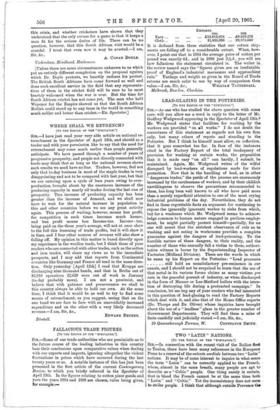FA,LLACIOUS TRADE FIGURES.
(TO TILE EDITOR OF THE “srscrAron..1 Sln,—Some of our trade authorities who are pessimistic as to the future course of the leading industries in this country base their conclusions upon comparative values when dealing with our exports and imports, ignoring altogether the violent fluctuations in prices which have occurred during the last twenty years or so. A notable instance of this has just been presented in the first article of the current Contemporary Review, to which you briefly referred in the Spectator of April 13th. In the figures relating to cotton piece goods and yarn the years 1884 and 1898 are chosen, value being given, for example Yarn ...
Cloth... It is deduced from these statistics that our cotton ship- ments are falling off to a considerable extent. When, how- ever, I point out that in 18E4 the average price of cotton per pound was exactly Od., and in 1898 just 3p, d., you will pee how fallacious the statement circulated is. The writer in , the review named says the "figures given are an irrefutable proof of England's industrial marasmus and approaching ruin." Yardage and weight as given in the Board of Trade returns are much safer to use by way of comparison than
EXPORTS.
1884. 1898.
113,813,078 ... £8,923,272 34859,336 ... 23,575,660 value.—I am, Sir, etc., WILLIAM TATTERSALL. Melbrook, Binvdon, Cheshire.






































 Previous page
Previous page